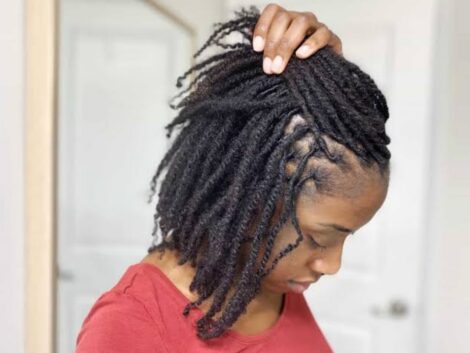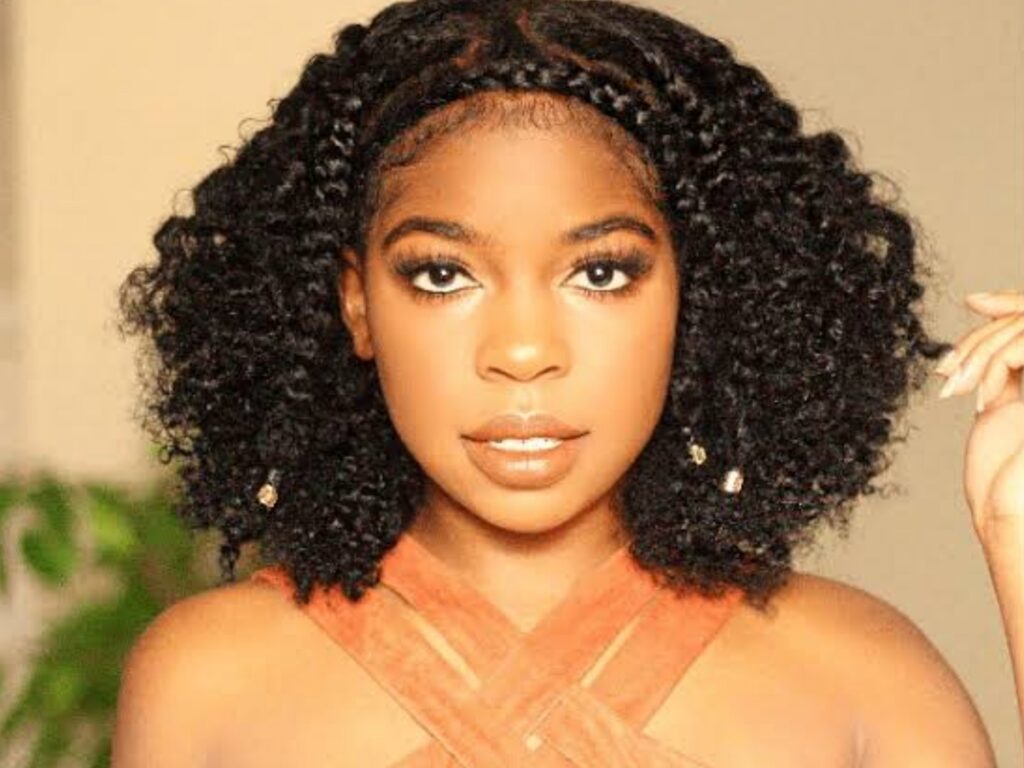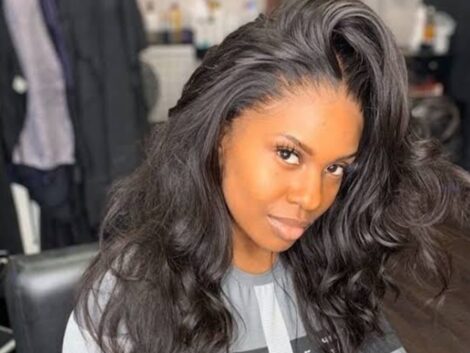There is no specific answer to this question, as the number of braids varies depending on the desired result, the texture of the hair, and personal preferences. It is easily understandable that the more braids you make, the more defined and tighter curls you will get. On the contrary- if you make fewer braids, your curl waves will look looser and larger.
At the starting point, it would be safe if you go for 6 to 12 braids. This is considered to be a range that allows a good balance of definition and volume. Yet it’s not constant, as people with thicker hair will require more braids to ensure even hair distribution and optimal results.
So, it depends on multiple factors and mostly on the desired result. Feel free to experiment and have an interesting hairstyle.
What Are Interlocks Hair?
Interlocks or sister locks are a method of maintaining natural hair locks or deadlocks. This technique involves using a small tool, like a tiny crochet hook or an interlocking needle, that interweaves the hair strands and creates a tightly interlocked pattern.
Interlocks are usually more uniform and smaller in size compared to the typical freeform or palm-rolled dreadlocks. This technique allows for greater control over the locks’ size, shape, and overall appearance.
Interlocking is commonly used by people with wavy, afro-textured, or tightly coiled hair who want to achieve a well-defined and neat style.
The interlocking process involves threading the tool through the base of a section of hair, creating a small hole or tunnel, and then pulling the tool back through the same hole, which is quite similar to crocheting. This interlocks the hair strands by creating a secure bond between them. The process is repeated throughout the hair, section by section, until all the desired locks are completely formed.
Interlocks require regular maintenance to prevent the new growth from causing tension and potential breakage at the roots. Maintenance typically involves- retightening the interlocks periodically and using the same interlocking tool to redo the pattern and keep the locks intact.
It’sIt’s important to note that interlocks are just one method of creating and maintaining dreadlocks, and several other techniques and approaches are available depending on personal preference and hair type.

When To Use Braidline?
A braidline, or a braided hairline or braided edge, is a popular hairstyle where small braids are created along the hairline or at the edges of the hair. This can be a unique and stylish touch to various hairstyles- as updos, ponytails, or even when keeping the hair down. You can use this style for various occasions and purposes. A few situations when you might go for using a braidline hairstyle are mentioned below:
- Everyday Style: You can incorporate braidline into your everyday style. It will provide you with a subtle yet stylish look while keeping your hair more manageable.
- Special Events: At events like- proms, parties, or weddings, braidline can be a fantastic hairstyling option. This will add an elegant detail to the overall look.
- Festival or Bohemian Look: At any music concert or similar sort of festival- creating a bohemian look is a popular choice, and braidline can be a part of your bohemian look that will make you stand out.
- Hair Accessories: Braid lines can also serve as a base for incorporating hair accessories. You can weave ribbons, flowers, or beads into the braids to further enhance your hairstyle and make it more festive or unique.
- Workout Hairstyle: While engaging in physical activity or sport- a braidline can help you keep your hair away from your face and add a stylish touch.
These are a few occasions or situations you can use braidline.

How Often Should You Interlock Starter Locs?
Interlocking starter locs are a maintenance technique that tightens the locs” roots. How often you need to do that varies depending on multiple factors. Such as hair growth, hair texture, and personal preferences. The general recommendation is to interlock starter locs every 4 to 6 weeks.
At the early stages of loc formation, it’s important to allow the hair to mat and lock on its own naturally. This process may take several months. Once the locs start to mature and get well-formed, interlocking can be introduced to help maintain the roots and promote neater and tighter locs.
However, you must avoid excessive interlocking, as this can cause thinning or breakage of the hair if done too frequently or with excessive tension. Over-manipulation of the roots can also hinder the natural locking process. It’sIt’s essential to strike a balance between maintaining the locs and allowing them to develop naturally.
It would be better if you consult with a professional loctician or stylist who specializes in loc maintenance. They can assess your hair and provide personalized recommendations on the frequency of interlocking based on your specific hair needs and loc progression.

Where is the best lace made?
When it comes to lace-made hairstyles, the “best” place to have them created would depend on various factors, including the expertise of the hairstylist or salon you choose. Different regions may have hairstylists with different specialties and skill sets. However, in general, some countries are renowned for their hairstyling industry and may offer excellent laced hairstyles.
For example, countries like France, Italy, and the United Kingdom have long-standing traditions in hairstyling and are known for their expertise in creating intricate and fashionable hairstyles. These countries often have hairstylists who specialize in creating elaborate updos and incorporating delicate accessories like lace into their designs.
Major cities such as Paris, Milan, London, and New York are known for their vibrant fashion and beauty scenes, and you are likely to find skilled hairstylists who can create stunning lace-made hairstyles in these locations.
However, it’s important to note that expertise can be found in various places around the world, and there are talented hairstylists everywhere. It’sIt’s recommended to do thorough research, look for recommendations, and read reviews to find a hairstylist who specializes in the type of hairstyle you desire, including lace-made hairstyles, regardless of their location.
Why do you interlock dreads?
Interlocking, also known as interlacing or palm rolling, is a technique used to maintain and tighten dreadlocks. It involves weaving the loose hair at the base of the dreadlock through the body of the lock itself. While interlocking is just one method among many for maintaining dreadlocks, it is often preferred by individuals who want to promote neater, more uniform-looking locks.
Here are a few reasons why some people choose to interlock their dreadlocks:
- Maintenance: Interlocking helps to tighten the roots of the dreadlocks, preventing them from unraveling or becoming loose. This technique can be particularly useful for individuals with hair textures that tend to produce frizz or loose hairs at the roots.
- Neat appearance: Interlocking can contribute to a more uniform and tidy appearance of the dreadlocks. By weaving the loose hairs into the core of each lock, it creates a smoother and more refined look.
- Versatility: Interlocking allows for greater versatility in styling dreadlocks. Tightly interlocked dreads tend to hold their shape well, making it easier to create various hairstyles and designs with the locks.
Although interlocking is not the only method for maintaining dreadlocks, different techniques may work better for different individuals depending on their hair type and personal preferences. It’sIt’s important to consult with a professional, or someone experienced in maintaining dreadlocks to determine the best approach for your specific hair type and desired outcome.
Lastly, check out the mane caper shop.


